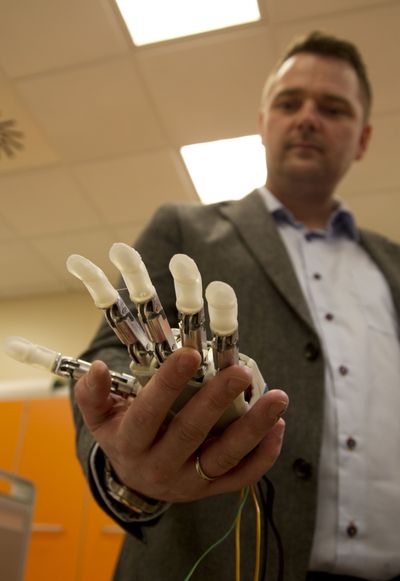New prosthetic hand adds sense of touch
Device allows amputee to tell shape, adjust grip

To feel what you touch – that’s the holy grail for artificial limbs. In a step toward that goal, European researchers created a robotic hand that let an amputee feel differences between a bottle, a baseball and a mandarin orange.
The patient only got to experiment with the bulky prototype for a week, and it’s far from the bionics of science fiction movies. But the research released Wednesday is part of a major effort to create more lifelike, and usable, prosthetics.
“It was just amazing,” said Dennis Aabo Sorensen of Aalborg, Denmark, who lost his left hand in a fireworks accident a decade ago and volunteered to pilot-test the new prosthetic. “It was the closest I have had to feeling like a normal hand.”
This isn’t the first time scientists have tried to give some sense of touch to artificial hands; a few other pilot projects have been reported in the U.S. and Europe. But this newest experiment, published in the journal Science Translational Medicine, shows Sorensen not only could tell differences in the shape and hardness of objects, he also could quickly react and adjust his grasp.
“It was interesting to see how fast he was able to master this,” said neuroengineer Silvestro Micera of Switzerland’s Ecole Polytechnique Federale de Lausanne, who led the Swiss and Italian research team.
Scientists have made great strides in recent years in improving the dexterity of prosthetics. But the sense of touch has been a much more difficult challenge, and is one reason that many patients don’t use their prosthetic hands as much as they’d like.
“You always have to look and see what’s going on, so that’s what is so much different from this new hand that I tried,” Sorensen, 36, said in a telephone interview.
First, doctors at Rome’s Gemelli Hospital implanted tiny electrodes inside two nerves – the ulnar and median nerves – in the stump of Sorensen’s arm.
Those nerves normally would allow for certain sensations in a hand. When researchers zapped them with a weak electrical signal, Sorensen said it felt like his missing fingers were moving, showing the nerves still could relay information.
Meanwhile, Micera’s team put sensors on two fingers of a robotic hand, to detect information about what the artificial fingers touched.
For one week, cords snaked from a bandage on Sorensen’s arm to the artificial hand, and the electrodes zapped the nerves in proportion to what the sensors detected.
They essentially created a loop that let the robotic hand rapidly communicate with Sorensen’s brain.
“It is really putting the brain back in control of the system,” said biomedical engineer Dustin Tyler of Case Western Reserve University, who wasn’t involved with the European work but leads a team in Ohio that recently created and tested a similar touch-enabled hand. “That’s an important step.”
Added neurobiologist Andrew Schwartz of the University of Pittsburgh: “It shows with a few sensors and some pretty elementary technology, that they can recover a fair amount of functionality.”
Micera cautioned that it will take several years of additional research to create a first-generation artificial hand that can feel, and looks more like a traditional prosthetic.
But a lot of work is underway.
In Ohio, Tyler’s team recently issued video showing a blindfolded man gently pulling stems from cherries without crushing them, thanks to similar implanted nerve stimulators and a sensor-equipped prosthetic hand.
In Pittsburgh, Schwartz’s team is about to test another approach – a brain-controlled robotic hand for the paralyzed that would “feel” through electrodes implanted in a brain region known as the sensory cortex.